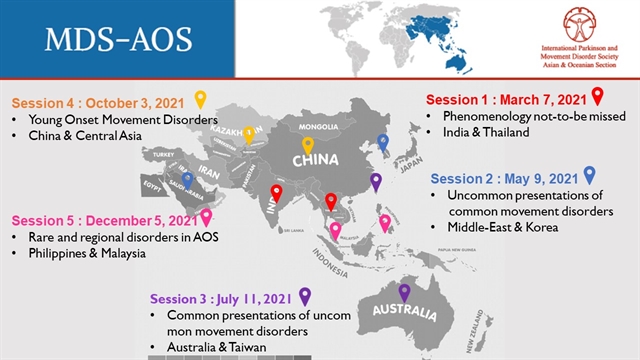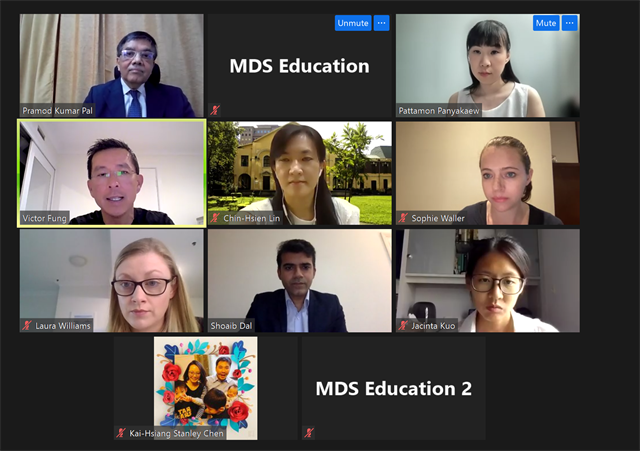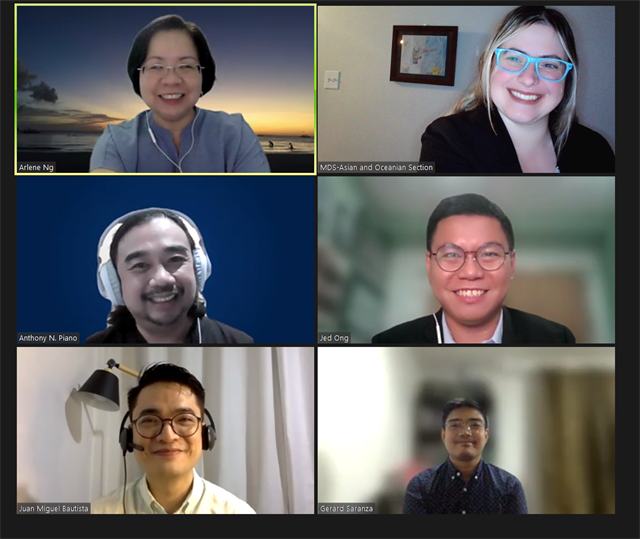 VOLUME 26, ISSUE 1 • March 2022. Full issue »
VOLUME 26, ISSUE 1 • March 2022. Full issue »

Highlights from the 2021 MDS-AOS Video Case Discussion Series
Share this: Tweet
The MDS-AOS Video Case Discussion Series was a five-part event starting in March 2021 and running through December 2021. This initiative was developed to fulfill the need from the education needs survey of the MDS Asian and Oceanian Section (MDS-AOS) members to engage interaction between countries by sharing interesting cases and best practices during the COVID-19 pandemic. The Course Directors were Dr. Pramod Kumar Pal, Professor of Neurology, National Institute of Mental Health & Neurosciences (NIMHANS), Bangalore, India and Dr. Pattamon Panyakaew, Assistant Professor of Neurology, Chulalongkorn Center of Excellence for Parkinson’s Disease and Related Movement Disorders, Chulalongkorn University, Bangkok, Thailand.
The learning objectives of this course were to recognize a collection of phenomenologies and acquire basic knowledge on how to approach various typical and atypical presentations of common and uncommon movement disorders, some of which are prevalent within the AOS. It was perceived that at the end of the course, the participants will be acquainted with a variety of common and uncommon movement disorders, more specifically of those unique to AOS region and have learnt skills for a systematic diagnostic approach for these disorders.
Each distinct two-hour session of the series focused on video cases, on a particular topic, from two different countries or regions within the MDS-AOS. Expert senior faculty (lead discussant) from ten different countries/regions were selected in collaboration with various local/regional societies within the MDS-AOS. They were instructed to have a team of presenters (colleagues/students) and select cases based on the topic allotted, with emphasis on the typical and atypical cases found in their region.
A total of 13 countries from MDS-AOS region participated in live video-case presentations; two countries presented in each part. We retained the format of video case discussion so that it is familiar to most our members, but pairing between two host countries was intended to increase engagement between two participating countries where national showcases were highlighted. Each country had a team of 2-5 presenters led by a senior faculty, and presented and discussed unique cases from their country. Each country was given 45 minutes to present cases and 15 minutes for question-and-answer.
The Senior Faculties included: (a) Part-1: Dr. Pattamon Panyakaew (Thailand), Dr. Pramod Kumar Pal (India); (b) Part-2: Dr. Shivam Mittal (United Arab Emirates) and Dr. Tae-Beom Ahn (Republic of Korea); (c) Part-3: Dr. Victor Fung (Australia) and Dr. Chin-Hsien Lin (Taiwan); (d) Part-4: Dr. Baorong Zhang (China) and Dr. Cholpon Shambetova (Kyrgyzstan); and (e) Part-5: Dr. Arlene R. Ng (Philippines) and Dr. Shen-Yang Lim (Malaysia).
Apart from the ten Senior Faculty (some of whom presented cases), there were 33 other faculty/trainees/fellows who presented and discussed cases (2 each from India and Taiwan, 3 each from Thailand, Middle East, Australia and Central Asia, 4 each from Korea, China and Philippines, and 5 from Malaysia). A total number of 75 video-based cases were present during the 5 Part Video Case Discussion Series.
Ms. Stephanie Jensen and Mr. Eric Johnson from MDS provided the secretarial assistance for the whole course.
Jump to:
Highlights: Session 1 | Session 2 | Session 3 | Session 4 | Session 5
Attendance | Feedback | Future Directions

Highlights:
Session 1: Phenomenologies not to be missed
The first part of the Video-Case discussion series was held on March 7, 2021 and had 17 cases from India and Thailand on the topic “Phenomenologies not to be missed”.
There was discussion on very well worked-up cases with characteristic neurological/clinical signs and/or common diagnostic findings which helps to clinch a diagnosis. India presented three groups of cases:
-
Ataxia with varied diagnostic eye movements (slow saccades in SCA2, downbeat nystagmus in SCA6 and anti-GAD antibody mediated ataxia, alternate skew deviation in Joubert Syndrome).
-
Diagnostic facial features in genetically mediated dystonias (silly smile in Wilson’s disease, facial grimacings in GM1 gangliosidosis type III, Mantis sign in PKAN and bulbous nose in DYT28 –KMT2B related dystonia).
-
Patients with characteristic myoclonus which clinched a diagnosis (slow myoclonus with characteristic EEG in SSPE, startle myoclonus and Cherry-red spot in GM2 gangliosidosis and brief photosensitive myoclonus with corresponding tri-phasic waves in CJD).
Thailand presented three groups of phenomenologies not to be missed:
-
Neuromuscular disorders which can mimic movement disorders (Myasthenia gravis with masseter weakness mimicking jaw-opening dystonia) and can present with abnormal movements (Hirayama disease presenting with polyminimyoclonus).
-
Recognition of unique phenomenology that can lead to precise localization (Holmes’ tremor with unilateral total ophthalmoplegia and contralateral monocular eye bobbing pointing to the pons to midbrain lesion) and etiology (subacute onset of exaggerated startle responses with encephalopathy pointing to progressive encephalitis with rigidity and myoclonus (PERM).
-
Bizarre movement due to frontal lobe epilepsy from neurocysticercosis in young adult is not equal to psychogenic disorders.
Thailand also highlighted the usefulness of neurophysiology tests in assisting the diagnosis of certain phenomenology.
Session 2: Uncommon presentations of common movement disorders
The second part of the Video-Case discussion series was held on May 9, 2021 and had 16 cases from UAE/Middle East and the Republic of Korea on the topic “Uncommon presentations of common movement disorders”.
Ten cases were presented by four speakers from the United Arab Emirates and Sudan. There were three categories:
-
PD patients with uncommon presentations: a PD patient with improvement of motor fluctuations with Zolpidem, a middle-aged man with PD having "belly dancing" truncal rest tremor with excellent response after DBS, and a PD patient presenting with cervical dystonia.
-
Genetic causes of juvenile onset PD (novel mutation of PARK2 gene and a case series of PINK1 mutation in Sudan).
-
Patients with unusual forms of dystonia (unusual clawing posture of hand in Panthothenate-kinase-associated neurodegeneration (PKAN), "sheesha/hukkah" (waterpipe) task specific oromandibular dystonia, levodopa-responsive dystonia-parkinsonism due to DNAJC6 mutations, VAC14 related dystonia-parkinsonism with good benefit from deep brain stimulation).
The highlights of the presentation from Korea included:
-
Asymmetric clinical presentation with unilateral MCP sign in a patient with MSA,
-
Apraxia of eyelid opening as an initial presentation of PSP,
-
Jaw opening and lingual dystonia as a presenting manifestation of SCA2,
-
Neck tremor in a patient with levosulpiride-induced movement disorder, and
-
A 16-year-old girl with gait problem due to heterozygous missense mutation of GCH1 gene.
Session 3: Common presentations of uncommon movement disorders
The third part of the Video-Case discussion series was held on July 11, 2021, and had 18 cases from Australia and Taiwan on “Common presentations of uncommon movement disorders”.
In presentations from Taiwan, three adults presented with progressive gait difficulty, but had varied uncommon disorders:
-
Human T-lymphotrophic virus type 1-associated myelopathy,
-
Autosomal dominant spastic paraplegia (SPG30), and
-
Stiff-person syndrome.

Another interesting observation was the presence of a relatively common imaging sign-the “Eye-of-the Tiger” on T2-W MRI in three different uncommon genetic movement disorders:
-
A 35-year-old lady with difficulty in writing and slurred speech since the age of 10 year diagnosed as PKAN (PANK2 mutation).
-
A 27-year-old man with rapid progressive generalized rigidity and slow response for 1 year diagnosed as MPAN (heterozygous C19orf12 mutation).
-
A 25-year-old man with slowly progressive cerebellar ataxia since early childhood diagnosed as SCA28 (de novo heterozygous AFG3L2 (c.2021_2023delCCT) mutation).
The last three patients presented with symptoms of varying parkinsonism and dystonia/myoclonus and diagnosed with uncommon disorders:
-
A 26-year man from the Philippines having generalized dystonia with mild parkinsonism, diagnosed as heterozygous TAF1 c.94C>T (p.Arg32Cys) mutation (DYT3),
-
A 24-year-old woman with occasional jerks and clumsiness for 9 years had a heterozygous ANO3 gene (DYT24) mutation, c.A2053G (p.S685G) on exon 21, and
-
A 51-year-old women with acute onset difficulties in pronunciation and hand movements found to have a heterozygous ATP1A3 (c.G1825A/p.D609N) substitution (Rapid-Onset Dystonia-Parkinsonism; DYT12).
The faculty stressed the importance of recognizing the typical presentation of diseases with combined phenomenology, closely observing the patient’s family members and awareness that de novo mutation always occurred.
The Australian team presented nine well-documented uncommon movement disorders: Nieman Pick disease (NPD), Chorea-acanthocytosis, CASPR 2-releated autoimmune syndrome, ANO10 heterozygote mutation, Sensory Ataxic Neuropathy Spectrum (SANDO) secondary to compound heterozygote mutation of POLG, SCA17, GABA‐transaminase deficiency, classic galactosemia and Gaucher’s disease.
The important observations made from Australia’s presentations included:
-
Adult onset NPD can have varied psychiatric presentations complicated by neuroleptics induced movement disorders. It is important to look for ataxia, supranuclear vertical gaze palsy, head retraction signs, and an absence of organomegaly should not dissuade one necessarily from this diagnosis.
-
In chorea-acanthocytosis, neuropsychiatric manifestations can be the first symptoms, and important clues for diagnosis include autosomal recessive inheritance, peripheral neuropathy, seizures and acanthocytes in peripheral blood smear.
-
Cognitive decline, emotional lability and jerky movements of trunk and extremities in an elderly often mandates investigations for autoimmune encephalitic syndromes.
These cases highlighted that psychosis or cognitive dysfunction can be a presenting clinical manifestation of a rare movement disorder syndrome. Examination of eye movement disorder can be an early and major diagnostic clue. Treatment with neuroleptics may confuse the clinical picture.
Diagnosis of adult onset sporadic ataxias is always a nightmare for the movement disorder specialists. The Australia team comprehensively presented 3 genetically worked up cases of sporadic adult onset progressive cerebellar ataxias. The final diagnosis included: (i) Compound heterozygote mutations of ANO10, (ii) Compound heterozygote mutations of POLG (formerly referred to as Sensory Ataxic Neuropathy Spectrum (SANDO), and (iii) SCA17.
Clues to these rare cases included:
-
Tortuous scleral vessels, downbeat nystagmus, bradykinesia, fasciculations, cognitive impairment, sphincter disturbances and pyramidal sign with severe cerebellar atrophy in ANO10 associated ataxias.
-
Cerebellar ataxia, clinical and electrophysiological evidence of sensory neuropathy, slow saccades and gaze restriction, bilateral mild ptosis, history of migraine and white matter lesions in cerebellar hemispheres and thalami in POLG mutation ataxias.
-
Progressive cerebellar ataxia with variable extrapyramidal signs (dystonia, chorea, parkinsonism), pyramidal signs, dementia, psychiatric disturbances, epilepsy, striatal hyperintensity (though non-specific) in SCA17.
The final three cases demonstrated “common” presentations of several uncommon, potentially treatable, childhood‐onset movement disorders (often labelled as “cerebral palsy”:
-
A 27-year-old woman with GABA‐transaminase deficiency (infantile/neonatal encephalopathy, seizures, hyperkinetic movements including choreoathetosis).
-
A 31-year-old lady with Galactosemia (intellectual disability, psychiatric complaints, dystonia, tremor, ataxia, premature ovarian failure).
-
A 31-year-old lady with Neuronopathic Gaucher’s disease (visceral involvement, horizontal gaze palsy, seizures, ataxia, intellectual disability).
Session 4: Young onset movement disorders
The fourth part of the Video Case discussion series was held on October 3, 2021, and had 15 cases from China and three Central Asian countries- Kyrgyzstan, Kazakhstan, and Uzbekistan on “Young Onset Movement Disorders”.
China presented three interesting cases of Young Onset Movement Disorders:
-
A 23-year old woman with recurrent episodes of involuntary movements after prolonged exercise for 13 years. She was finally diagnosed to have a heterozygous variant in the gene SLC2A1: c.997C>T p.R333W.
-
A patient with early-onset parkinsonism with mild cognitive impairment diagnosed with PSEN1, the causative gene of Alzheimer's disease.
-
A 34-year old man with early onset Parkinson disease diagnosed with deletion in exon 3 of PARK2 gene.
It was emphasized that patient with PSEN1 mutation could present with prominent early-onset parkinsonism which might be atypical for any atypical parkinsonisms (like PSP, CBD or MSA) and a long-term follow-up is warranted.
The three Central Asian countries presented several interesting cases of young-onset movement disorders. A 54-year old patient with first symptoms of “writers cramp” at the age of 13 years was later found to have a heterozygous missense variant in THAP1 (NM_018105.3) c.52A>C, p.(Lys18Gln) (DYT6). Interestingly, later in the course trihexiphenydil treatment completely changed the clinical phenotype to a predominantly choreiform disorder, thereby emphasizing the fact that it is important to document the nature of 1st symptom (focal hand dystonia) and subsequent drug-induced movement disorders can mislead the clinician. This patient had an excellent improvement with bilateral GPi DBS.
Other interesting well demonstrated cases included 3 patients with Wilson’s disease and children with Benign neonatal sleep myoclonus and West syndrome.
Session 5: Rare and regional movement disorders in AOS
The fifth part of the Video-Case discussion series was held on December 5, 2021, and had eight genetically proven cases from Philippines and Malaysia on “Rare and regional movement disorders in AOS”.
The most important cases of historical importance and first described from Panay island of Philippines- X-linked dystonia-parkinsonism (XDP; DYT3) (Lubag disease) were presented and it was emphasized that females can also be symptomatic. Other cases from Philippines included Ataxia Telangiectasia, DYT11 and a case of Opsoclonus-Myoclonus-Ataxia syndrome in a patient with tuberculous meningitis and HIV infection.
The presentations from Malaysia emphasized on the genetic YOPD and included PINK1 (p.Leu347Pro) mutation, PRKN mutation, a severe cognitively impaired YOPD patient with DJ-1 mutation, and a patient with GBA p.G241R (LP) mutation + single heterozygous PRKN exon 3 deletion.

Attendance :
Overall, there were 833 registrations (96% were MDS members) from 72 countries, with a maximum concurrent view of 163. Two-thirds of the registrations were from the AOS countries and 83.5% of the attendees were from the AOS region. The top attending countries were Thailand, India, Taiwan, Australia, Malaysia, Republic of Korea, Indonesia, Singapore, United Kingdom and Romania.
Feedback:
(a) Quality of the course:
95-100% of participants agreed that the program was of high quality and informative, interesting, well organized and the content met the objectives and was relevant to their practice or research. The program was perceived as a great resource for learning more about movement disorders and majority agreed that they would change their practice or approach to research as a result of the program and would recommend this course to a colleague.
(b) Perceived changes after the course:
Many delegates expressed their views on how the knowledge gained from this course will change their practice: (i) a better understanding of symptom details and phenomenological clues of common and rare movement disorders, which will help them in a systematic approach to their patients, (ii) a greater awareness of uncommon presentations of common movement disorders as well as young onset movement disorders, (iii) a greater confidence in diagnosis of disorders with myoclonus and dystonia and awareness of neuromuscular tremor mimics, (iv) the importance of recognizing subtle abnormalities of eye movements which may aid in differential diagnosis of various movement disorders, (v) the appropriate use of diagnostic tests for paraneoplastic or post-infectious markers, and (vi) an increased awareness and confidence in diagnosing genetic disorders and the utility of currently available genetic tests.
(c) Suggestions for improvement in Future Courses:
At the end of each session, the delegates provided important feedback on how to improve future courses. Some of the important suggestions include: (i) to slow down the pace of the presentation to make it easier to keep up with all the information being presented, especially for the non-native English speakers, (ii) to include more video cases and spend more time on examination, (iii) to include more information on rehabilitation and physiotherapy, (iv) to provide more opportunities for attendee interaction and participation and provide more time to discuss the cases and ask questions, (v) improvement of the quality of video of some cases, and (vii) to focus discussion on clinical diagnosis before genetic testing, as not all participants have the capability of genetic sequencing, especially in low resource countries.
Conclusions and Future Directions:
The MDS-AOS Video Case Discussion Series is a longitudinal educational program where the faculties from different countries in the AOS can share their experiences on recognizing various phenomenologies and guiding clinical approaches of these interesting cases . We hope that this course will serve as a flagship and continue as a tradition of our section and faculties from more countries could be involved and share their interesting cases in the future.
Share this: Tweet
Read more Moving Along:






